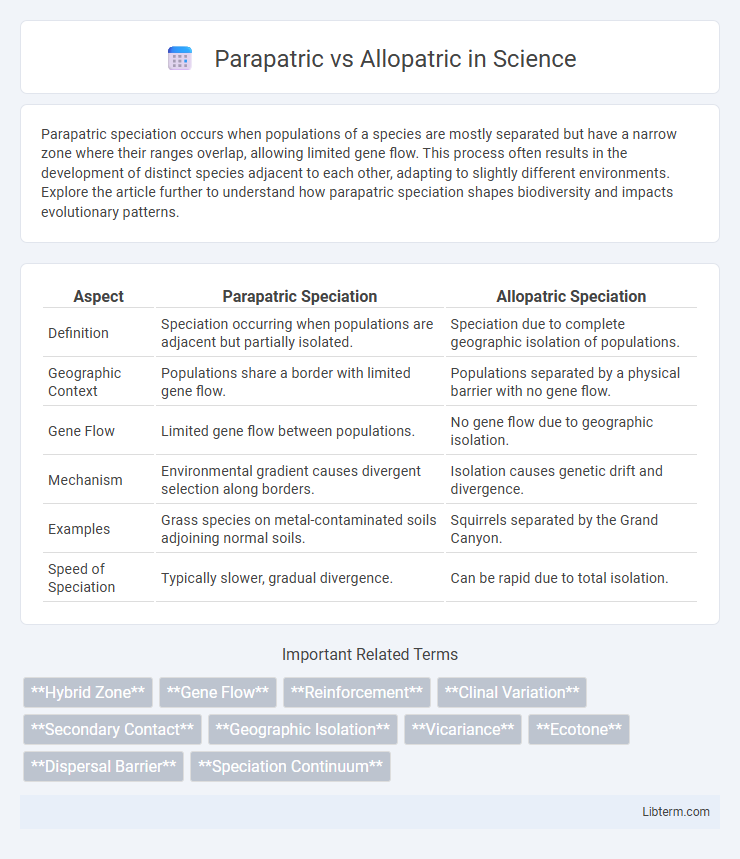Parapatric speciation occurs when populations of a species are mostly separated but have a narrow zone where their ranges overlap, allowing limited gene flow. This process often results in the development of distinct species adjacent to each other, adapting to slightly different environments. Explore the article further to understand how parapatric speciation shapes biodiversity and impacts evolutionary patterns.
Table of Comparison
| Aspect | Parapatric Speciation | Allopatric Speciation |
|---|---|---|
| Definition | Speciation occurring when populations are adjacent but partially isolated. | Speciation due to complete geographic isolation of populations. |
| Geographic Context | Populations share a border with limited gene flow. | Populations separated by a physical barrier with no gene flow. |
| Gene Flow | Limited gene flow between populations. | No gene flow due to geographic isolation. |
| Mechanism | Environmental gradient causes divergent selection along borders. | Isolation causes genetic drift and divergence. |
| Examples | Grass species on metal-contaminated soils adjoining normal soils. | Squirrels separated by the Grand Canyon. |
| Speed of Speciation | Typically slower, gradual divergence. | Can be rapid due to total isolation. |
Introduction to Speciation
Parapatric speciation occurs when populations of a species are partially separated and experience limited gene flow across neighboring environments, allowing divergence due to varying selective pressures. Allopatric speciation arises from complete geographic isolation, leading to reproductive isolation and genetic differentiation over time. Both processes contribute to biodiversity by creating distinct species through adaptive evolution under different spatial configurations.
Defining Parapatric and Allopatric Speciation
Parapatric speciation occurs when populations of a species occupy adjacent but non-overlapping geographic areas, allowing limited gene flow that leads to divergence primarily through environmental gradients or selection pressures. Allopatric speciation involves complete geographic isolation, which prevents gene flow between populations, causing genetic divergence and the formation of new species. Both modes highlight distinct spatial patterns influencing reproductive isolation and evolutionary processes.
Geographic Separation in Speciation
Parapatric speciation occurs when populations are partially separated by geographic barriers, allowing limited gene flow along a gradient, whereas allopatric speciation involves complete geographic isolation preventing any gene exchange. Geographic separation in allopatric speciation typically results from physical barriers such as mountains, rivers, or distance, leading to distinct evolutionary paths. In parapatric speciation, the adjacent populations experience divergent selection pressures across environmental gradients, promoting speciation despite some level of contact.
Key Mechanisms of Parapatric Speciation
Parapatric speciation occurs when populations are adjacent and experience varying selection pressures across a gradient, leading to limited gene flow and divergence. Key mechanisms include environmental heterogeneity causing differential adaptation, partial geographic isolation, and assortative mating within hybrid zones. These factors collectively drive reproductive isolation without complete physical separation, distinguishing parapatric from allopatric speciation where populations are fully geographically isolated.
Processes Involved in Allopatric Speciation
Allopatric speciation involves geographic isolation where a population is divided by physical barriers such as mountains, rivers, or distance, preventing gene flow between groups. Over time, genetic divergence occurs through mutation, natural selection, and genetic drift, leading to reproductive isolation. This process results in the emergence of distinct species adapted to their unique environments.
Genetic Divergence and Isolation
Parapatric speciation occurs when populations are partially separated, allowing limited gene flow and leading to genetic divergence driven by environmental gradients and selection pressures. Allopatric speciation arises from complete geographic isolation, preventing gene flow entirely and causing genetic divergence primarily through genetic drift and mutation accumulation. Isolation intensity directly impacts the rate and nature of genetic divergence, with allopatry typically producing more distinct genetic differences compared to parapatry.
Real-world Examples of Parapatric Speciation
Parapatric speciation occurs when populations are adjacent but experience partial geographic isolation that limits gene flow, leading to distinct species. A real-world example includes the grass species *Anthoxanthum odoratum* in mine-contaminated soils where heavy metal tolerance forms a cline with adjacent non-tolerant populations. Another case is the Ensatina salamander complex in California, where neighboring populations exhibit gradual morphological changes along a geographic gradient, ultimately resulting in reproductive isolation.
Notable Cases of Allopatric Speciation
Allopatric speciation is exemplified by Darwin's finches in the Galapagos Islands, where geographic isolation led to the divergence of multiple species from a common ancestor. The formation of the Isthmus of Panama also caused allopatric speciation by separating marine populations into Atlantic and Pacific species. In contrast, parapatric speciation occurs with adjacent populations experiencing partial isolation, often along environmental gradients, without strict geographic barriers.
Comparing Evolutionary Outcomes
Parapatric speciation occurs when populations are adjacent with limited gene flow, leading to divergent evolution primarily driven by environmental gradients and partial genetic isolation. Allopatric speciation involves complete geographic separation, resulting in reproductive isolation through genetic drift and natural selection in distinct environments. Evolutionary outcomes in parapatric speciation often include clinal variations and hybrid zones, whereas allopatric speciation typically produces distinct species with clear genetic divergence and no interbreeding.
Summary and Future Perspectives
Parapatric speciation occurs when populations are adjacent with partial gene flow, while allopatric speciation involves complete geographic isolation preventing gene flow. Current research emphasizes genomic divergence patterns and environmental gradients to differentiate these processes. Future perspectives include leveraging advanced genomic tools and ecological modeling to unravel speciation mechanisms and predict biodiversity responses to environmental changes.
Parapatric Infographic

 libterm.com
libterm.com